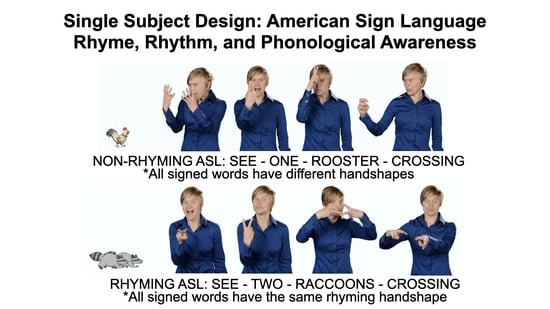Effects of ASL Rhyme and Rhythm on Deaf Children’s Engagement Behavior and Accuracy in Recitation: Evidence from a Single Case Design
Abstract
:1. Introduction
1.1. Literature Review
1.2. Engagement and Recitation
1.3. Deaf Learners
1.4. Sign Language Impairments and Language Deprivation
- (1)
- What are the effects of rhyming and non-rhyming conditions of ASL stories on Deaf children’s engagement behavior?
- (2)
- What are the effects of rhyming and non-rhyming conditions of ASL stories on Deaf children’s accuracy in recitation?
- (3)
- What are the effects of handshape rhyme awareness instruction on Deaf children’s engagement behavior and accuracy in recitation?
2. Method
2.1. Alternating Treatments Design
2.2. Participants and Setting
3. Materials
4. Measures
4.1. Baseline Assessments
4.2. Social Vailidity Questionnaire
4.3. Independent and Dependent Variables
4.4. Data-Recording Procedures
4.5. Procedural Integrity
4.6. Inter-Rater Reliability
4.7. Visual Analysis
4.8. Total Mean and Mean Difference
5. Procedure
6. Results
6.1. Engagement
6.2. Recitation
6.3. Visual Graphs
6.3.1. Daya
6.3.2. Yair
6.3.3. Giada and Jaslene
6.3.4. Lexie
6.3.5. *Lacey
6.4. Social Validity Questionnaire
7. Discussion
7.1. Engagement and Imitation
7.2. Recitation and Phonological Awareness
7.3. Student Performance
7.4. Social Validity
7.5. Limitations and Future Directions
8. Conclusions
Author Contributions
Funding
Conflicts of Interest
Appendix A

References
- Meltzoff, A.N.; Kuhl, P.K. Exploring the infant social brain: What’s going on in there. Zero Three 2016, 36, 2–9. [Google Scholar]
- Bryant, P.E.; MacLean, M.; Bradley, L.L.; Crossland, J. Rhyme and alliteration, phoneme detection, and learning to read. Dev. Psychol. 1990, 26, 429–438. [Google Scholar] [CrossRef]
- Brown, C.S. Language and literacy development in the early years: Foundational skills that support emergent readers. Lang. Lit. Spectr. 2014, 24, 35–49. [Google Scholar]
- Moritz, C.; Yampolsky, S.; Papadelis, G.; Thomson, J.; Wolf, M. Links between early rhythm skills, musical training, and phonological awareness. Read. Writ. 2013, 26, 739–769. [Google Scholar] [CrossRef]
- Moses, A.M.; Golos, D.B.; Roemen, B.; Cregan, G.E. The current state of early literacy for deaf and hearing children: A survey of early childhood educators. J. Early Child. Lit. 2018, 18, 373–395. [Google Scholar] [CrossRef]
- Gannon, J. Deaf Heritage: A Narrative History of Deaf America; Gallaudet University Press: Washington, DC, USA, 2011; ISBN 978-1-56368-515-6. [Google Scholar]
- Stokoe, W.C.; Casterline, D.C.; Croneberg, C.G. A Dictionary of American Sign Language on Linguistic Principles; Gallaudet University Press: Washington, DC, USA, 1965. [Google Scholar]
- Goldin-Meadow, S.; Mayberry, R.I. How do profoundly deaf children learn to read? Learn. Disabil. Res. Pract. 2001, 16, 222–229. [Google Scholar] [CrossRef]
- Hoffmeister, R.J.; Caldwell-Harris, C.L. Acquiring English as a second language via print: The task for deaf children. Cognition 2014, 132, 229–242. [Google Scholar] [CrossRef]
- Miller, P.; Clark, M.D. Phonemic Awareness is Not Necessary to Become a Skilled Deaf Reader. J. Dev. Phys. Disabil. 2011, 23, 459. [Google Scholar] [CrossRef]
- Hall, W.C. What you don’t know can hurt you: The risk of language deprivation by impairing sign language development in deaf children. Matern. Child Health J. 2017, 21, 961–965. [Google Scholar] [CrossRef] [Green Version]
- Strong, M.; Stuckless, R. A review of bilingual/bicultural programs for deaf children in North America. Am. Ann. Deaf. 1995, 140, 83–94. [Google Scholar] [CrossRef]
- Crume, P.K. Teachers’ perceptions of promoting sign language phonological awareness in an ASL/English bilingual program. J. Deaf Stud. Deaf Educ. 2013, 18, 464–488. [Google Scholar] [CrossRef] [PubMed] [Green Version]
- Chukovsky, K. From Two to Five; University of California Press: Berkeley, CA, USA, 1963; ISBN 978-0-520-00238-8. [Google Scholar]
- Petitto, L.A.; Langdon, C.; Stone, A.; Andriola, D.; Kartheiser, G.; Cochran, C. Visual sign phonology: Insights into human reading and language from a natural soundless phonology. Wiley Interdiscip. Rev. Cogn. Sci. 2016, 7, 366–381. [Google Scholar] [CrossRef] [PubMed]
- Ferjan Ramírez, N.; Lytle, S.R.; Kuhl, P.K. Parent coaching increases conversational turns and advances infant language development. Proc. Natl. Acad. Sci. USA 2020, 117, 3484–3491. [Google Scholar] [CrossRef] [PubMed] [Green Version]
- Anthony, J.; Francis, D. Development of Phonological Awareness. Curr. Dir. Psychol. Sci. 2005, 14, 255–259. [Google Scholar] [CrossRef]
- Adams, M.J. Beginning to Read: Thinking and Learning about Print; The MIT Press: Cambridge, MA, USA, 1990. [Google Scholar]
- Shanahan, T. (Ed.) Developing Early Literacy: Report of the National Early Literacy Panel; National Institute for Literacy: Washington, DC, USA, 2008.
- Flett, A.; Conderman, G. Promote phonemic awareness. Interv. Sch. Clin. 2002, 37, 242–245. [Google Scholar] [CrossRef]
- Goswami, U. Early phonological development and the acquisition of literacy. In Handbook of Early Literacy Research; Guilford Press: New York, NY, USA, 2003; Volume 1, ISBN 978-1-57230-895-4. [Google Scholar]
- Patscheke, H.; Degé, F.; Schwarzer, G. The effects of training in music and phonological skills on phonological awareness in 4- to 6-year-old children of immigrant families. Front. Psychol. 2016, 7. [Google Scholar] [CrossRef] [Green Version]
- Williams, M.; Rask, H. Literacy through play: How families with able children support their literacy development. Early Child Dev. Care 2003, 173, 527–533. [Google Scholar] [CrossRef]
- Dunst, C.J.; Gorman, E. Nursery rhymes and the early communication, language and literacy development of young children with disabilities. Cent. Early Lit. Learn. 2011, 4, 1–11. [Google Scholar]
- Georgiadou, I.; Knight, R.A.; Dipper, L. Exploring duration and isochrony in nursery rhyme reciting for children with language impairments and typically developing children. In Proceedings of the ICPhS, Glasgow, UK, 10–14 August 2015. [Google Scholar]
- Svalberg, A.M.-L. Engagement with Language: Interrogating a Construct. Lang. Aware. 2009, 18, 242–258. [Google Scholar] [CrossRef] [Green Version]
- Vaiouli, P.; Grimmet, K.; Ruich, L.J. “Bill is now singing”: Joint engagement and the emergence of social communication of three young children with autism. Autism Int. J. Res. Pract. 2015, 19, 73–83. [Google Scholar] [CrossRef]
- Gold, C.; Voracek, M.; Wigram, T. Effects of music therapy for children and adolescents with psychopathology: A meta-analysis. J. Child Psychol. Psychiatry 2004, 45, 1054–1063. [Google Scholar] [CrossRef] [PubMed]
- Perry, M.M.R. Relating improvisational music therapy with severely and multiply disabled children to communication development. J. Music Ther. 2003, 40, 227–246. [Google Scholar] [CrossRef] [PubMed] [Green Version]
- Calvert, S.L.; Billingsley, R.L. Young children’s recitation and comprehension of information presented by songs. J. Appl. Dev. Psychol. 1998, 19, 97–108. [Google Scholar] [CrossRef] [Green Version]
- Calvert, S.L.; Tart, M. Song versus verbal forms for very-long-term, long-term, and short-term verbatim recall. J. Appl. Dev. Psychol. 1993, 14, 245–260. [Google Scholar] [CrossRef]
- Fernandez-Fein, S.; Baker, L. Rhyme and alliteration sensitivity and relevant experiences among preschoolers from diverse backgrounds. J. Lit. Res. 1997, 29, 433–459. [Google Scholar] [CrossRef] [Green Version]
- Johnson, J.L.; Hayes, D.S. Preschool children’s retention of rhyming and nonrhyming text: Paraphrase and rote recitation measures. J. Appl. Dev. Psychol. 1987, 8, 317–327. [Google Scholar] [CrossRef]
- Sheingold, K.; Foundas, A. Rhymes for some reasons: Effect of rhyme on children’s memory for detail and sequence in simple narratives. Psychol. Rep. 1978, 43, 1231–1234. [Google Scholar] [CrossRef]
- Read, K.; Macauley, M.; Furay, E. The seuss boost: Rhyme helps children retain words from shared storybook reading. First Lang. 2014, 34, 354–371. [Google Scholar] [CrossRef]
- Valli, C. Poetics of American Sign Language. Ph.D. Thesis, The Union Institute, Cincinnati, OH, USA, 1993. [Google Scholar]
- Blondel, M.; Miller, C. Movement and rhythm in nursery rhymes in LSF. Sign Lang. Stud. 2001, 2, 24–61. [Google Scholar] [CrossRef]
- Snoddon, K. Action Research with a Family ASL Literacy Program. Writ. Pedagog. 2011, 3, 265–288. [Google Scholar] [CrossRef]
- Bonvillian, J.D.; Siedlecki, T. Young Children’s Acquisition of the Location Aspect of American Sign Language Signs: Parental Report Findings. J. Commun. Disord. 1996, 29, 13–35. [Google Scholar] [CrossRef]
- Siedlecki, T.; Bonvillian, J.D. Location, handshape & movement: Young children’s acquisition of the formational aspects of American Sign Language. Sign Lang. Stud. 1993, 78, 31–52. [Google Scholar] [CrossRef]
- Braem, P.B. Acquisition of the handshape in American Sign Language: A preliminary analysis. In From Gesture to Language in Hearing and Deaf Children; Springer Series in Language and Communication; Volterra, V., Erting, C.J., Eds.; Springer: Berlin/Heidelberg, Germany, 1990; pp. 107–127. ISBN 978-3-642-74859-2. [Google Scholar]
- Conlin, K.E.; Mirus, G.R.; Mauk, C.; Meier, R.P. The acquisition of first signs: Place, handshape, and movement. In Language Acquisition by Eye; Lawrence Erlbaum Associates Publishers: Mahwah, NJ, USA, 2000; pp. 51–69. ISBN 978-0-8058-2937-2. [Google Scholar]
- Di Perri, K. ASL Phonemic Awareness in Deaf Children: Implications for Instruction. Ph.D. Thesis, Boston University, Boston, MA, USA, 2004. [Google Scholar]
- Andrews, J.F.; Baker, S. ASL Nursery Rhymes: Exploring a Support for Early Language and Emergent Literacy Skills for Signing Deaf Children. Sign Lang. Stud. 2019, 20, 5–40. [Google Scholar] [CrossRef]
- Petitto, L.A.; Zatorre, R.J.; Gauna, K.; Nikelski, E.J.; Dostie, D.; Evans, A.C. Speech-Like Cerebral Activity in Profoundly Deaf People Processing Signed Languages: Implications for the Neural Basis of Human Language. Proc. Natl. Acad. Sci. USA 2000, 97, 13961–13966. [Google Scholar] [CrossRef] [Green Version]
- Petitto, L.A.; Katerelos, M.; Levy, B.G.; Gauna, K.; Tétreault, K.; Ferraro, V. Bilingual signed and spoken language acquisition from birth: Implications for the mechanisms underlying early bilingual language acquisition. J. Child Lang. 2001, 28, 453–496. [Google Scholar] [CrossRef] [Green Version]
- Petitto, L.-A. New Discoveries from the Bilingual Brain and Mind across the Life Span: Implications for Education. Mind Brain Educ. 2009, 3, 185–197. [Google Scholar] [CrossRef] [Green Version]
- McQuarrie, L.; Abbott, M. Bilingual Deaf Students’ Phonological Awareness in ASL and Reading Skills in English. Sign Lang. Stud. 2013, 14, 80–100. [Google Scholar] [CrossRef]
- Mayberry, R.I.; del Giudice, A.A.; Lieberman, A.M. Reading achievement in relation to phonological coding and awareness in deaf readers: A meta-analysis. J. Deaf Stud. Deaf Educ. 2011, 16, 164–188. [Google Scholar] [CrossRef]
- Gietz, M.R.; Andrews, J.F.; Clark, M.D. ASL Stories with Handshape Rhyme: An Exploratory Intervention to Support English Vocabulary with Signing Deaf Readers. Arch. Psychol. 2020, 4, 1–24. [Google Scholar] [CrossRef]
- Corina, D.P.; Hafer, S.; Welch, K. Phonological awareness for American Sign Language. J. Deaf Stud. Deaf Educ. 2014, 19, 530–545. [Google Scholar] [CrossRef] [Green Version]
- Quinto-Pozos, D.; Singleton, J.L.; Hauser, P.C. A case of specific language impairment in a deaf signer of American Sign Language. J. Deaf Stud. Deaf Educ. 2017, 22, 204–218. [Google Scholar] [CrossRef] [PubMed]
- Hall, W.C.; Levin, L.L.; Anderson, M.L. Language deprivation syndrome: A possible neurodevelopmental disorder with sociocultural origins. Soc. Psychiatry Psychiatr. Epidemiol. 2017, 52, 761–776. [Google Scholar] [CrossRef] [PubMed] [Green Version]
- Henner, J.; Novogrodsky, R.; Reis, J.; Hoffmeister, R. Recent issues in the use of signed language assessments for diagnosis of language disorders in signing deaf and hard of hearing children. J. Deaf Stud. Deaf Educ. 2018, 23, 307–316. [Google Scholar] [CrossRef] [PubMed]
- Cheng, Q.; Roth, A.; Halgren, E.; Mayberry, R.I. Effects of Early Language Deprivation on Brain Connectivity: Language Pathways in Deaf Native and Late First-Language Learners of American Sign Language. Front. Hum. Neurosci. 2019, 13. [Google Scholar] [CrossRef] [PubMed] [Green Version]
- Mayberry, R.I. First-language acquisition after childhood differs from second-language acquisition: The case of American Sign Language. J. Speech Hear. Res. 1993, 36, 1258–1270. [Google Scholar] [CrossRef]
- Mayberry, R.I.; Eichen, E.B. The long-lasting advantage of learning sign language in childhood: Another look at the critical period for language acquisition. J. Mem. Lang. 1991, 30, 486–512. [Google Scholar] [CrossRef]
- Mayberry, R.I.; Fischer, S.D. Looking through phonological shape to lexical meaning: The bottleneck of non-native sign language processing. Mem. Cognit. 1989, 17, 740–754. [Google Scholar] [CrossRef] [Green Version]
- Barlow, D.H.; Hayes, S.C. Alternating treatments design: One strategy for comparing the effects of two treatments in a single subject. J. Appl. Behav. Anal. 1979, 12, 199–210. [Google Scholar] [CrossRef] [Green Version]
- Hains, A.H.; Baer, D.M. Interaction effects in multielement designs: Inevitable, desirable, and ignorable. J. Appl. Behav. Anal. 1989, 22, 57–69. [Google Scholar] [CrossRef] [Green Version]
- Horner, R.H.; Carr, E.G.; Halle, J.; McGee, G.; Odom, S.; Wolery, M. The use of single-subject research to identify evidence-based practice in special education. Except. Child. 2005, 71, 165–179. [Google Scholar] [CrossRef]
- What Works Clearinghouse Reviewer Guidance for Use with the Procedures and Standards Handbook. Available online: https://ies.ed.gov/ncee/wwc/Studyreviewguide (accessed on 15 March 2019).
- Simms, L.; Baker, S.; Clark, D.M. The Standardized Visual Communication and Sign Language Checklist for Signing Children. Sign Lang. Stud. 2013, 14, 101–124. [Google Scholar] [CrossRef]
- Hammond, D.; Gast, D.L. Descriptive analysis of single subject research designs: 1983–2007. Educ. Train. Autism Dev. Disabil. 2010, 45, 187–202. [Google Scholar]
- Manolov, R.; Onghena, P. Analyzing data from single-case alternating treatments designs. Psychol. Methods. 2018, 23, 480–504. [Google Scholar] [CrossRef] [PubMed] [Green Version]
- Shadish, W.R.; Sullivan, K.J. Characteristics of single-case designs used to assess intervention effects in 2008. Behav. Res. Methods 2011, 43, 971–980. [Google Scholar] [CrossRef] [PubMed] [Green Version]
- Smith, J.D. Single-case experimental designs: A systematic review of published research and current standards. Psychol. Methods 2012, 17. [Google Scholar] [CrossRef] [PubMed] [Green Version]
- Kratochwill, T.R.; Hitchcock, J.H.; Horner, R.H.; Levin, J.R.; Odom, S.L.; Rindskopf, D.M.; Shadish, W.R. Single-case intervention research design standards. Remedial Spec. Educ. 2013, 34, 26–38. [Google Scholar] [CrossRef] [Green Version]
- Lane, J.D.; Gast, D.L. Visual analysis in single case experimental design studies: Brief review and guidelines. Neuropsychol. Rehabil. 2014, 24, 445–463. [Google Scholar] [CrossRef]
- Gast, D.L. Single Subqject Research Methodology in Behavioral Sciences; Routledge: New York, NY, USA, 2010; ISBN 978-1-135-59319-3. [Google Scholar]
- Lindahl, M.; Pramling-Samuelsson, I. Imitation and Variation: Reflections on toddlers’ strategies for learning. Scand. J. Educ. Res. 2002, 46, 25–45. [Google Scholar] [CrossRef]
- Bolduc, J.E.; Lefebvre, P.A.E. Using nursery rhymes to foster phonological and musical processing skills in kindergarteners. Creat. Educ. 2012, 3, 495–502. [Google Scholar] [CrossRef] [Green Version]
- Tillmann, B.; Dowling, W.J. Memory decreases for prose, but not for poetry. Mem. Cognit. 2007, 35, 628–639. [Google Scholar] [CrossRef]
- Bower, G.H.; Bolton, L.S. Why are rhymes easy to learn? J. Exp. Psychol. 1969, 82, 453–461. [Google Scholar] [CrossRef] [Green Version]
- Engel, S. Storytelling in the First Three Years. Zero Three 1997, 2, 3–6. [Google Scholar]
- Bloom, L.; Hood, L.; Lightbown, P. Imitation in language development: If, when, and why. Cogn. Psychol. 1974, 6, 380–420. [Google Scholar] [CrossRef]
- Long, L.E. Productions of Metalinguistic Awareness by Young Children with SLI and Typical Language. Master’s Thesis, East Tennessee State University, Johnson City, TN, USA, 2015, unpublished dissertation. [Google Scholar]
- Chaney, C. Language development, metalinguistic skills, and print awareness in 3-year-old children. Appl. Psycholinguist. 1992, 13, 485–514. [Google Scholar] [CrossRef]
- Fazio, B.B. Memory for Rote Linguistic Routines and Sensitivity to Rhyme: A Comparison of Low-Income Children with and without Specific Language Impairment. Appl. Psycholinguist. 1997, 18, 345–372. [Google Scholar] [CrossRef]
- Ozernov-Palchik, O.; Norton, E.S.; Sideridis, G.; Beach, S.D.; Wolf, M.; Gabrieli, J.D.E.; Gaab, N. Longitudinal stability of pre-reading skill profiles of kindergarten children: Implications for early screening and theories of reading. Dev. Sci. 2017, 20, 12471. [Google Scholar] [CrossRef]
- Bourdieu, P. The forms of capital. In Handbook of Theory and Research for the Sociology of Education; Greenwood Press: New York, NY, USA, 1986; pp. 241–258. [Google Scholar]


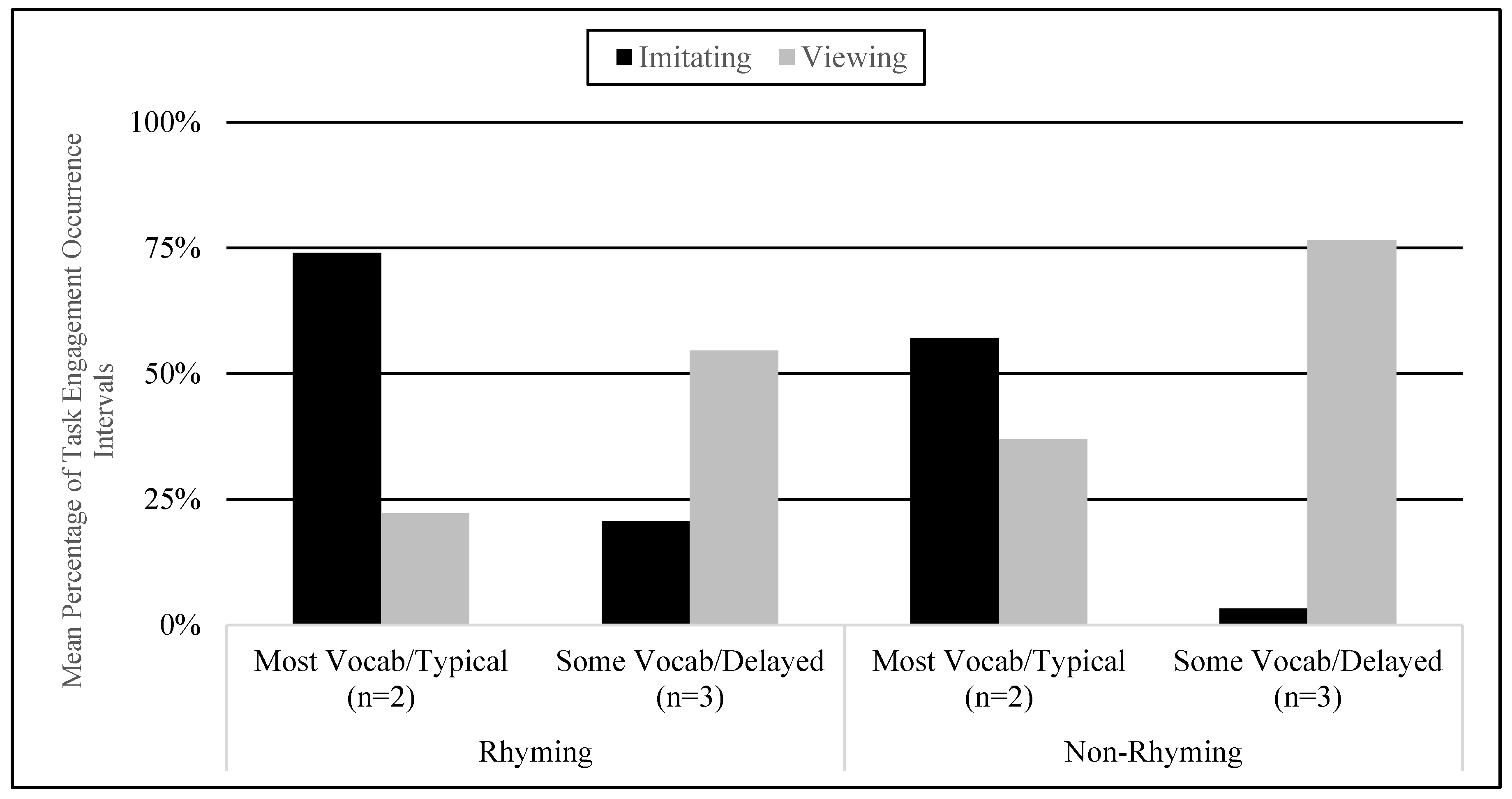

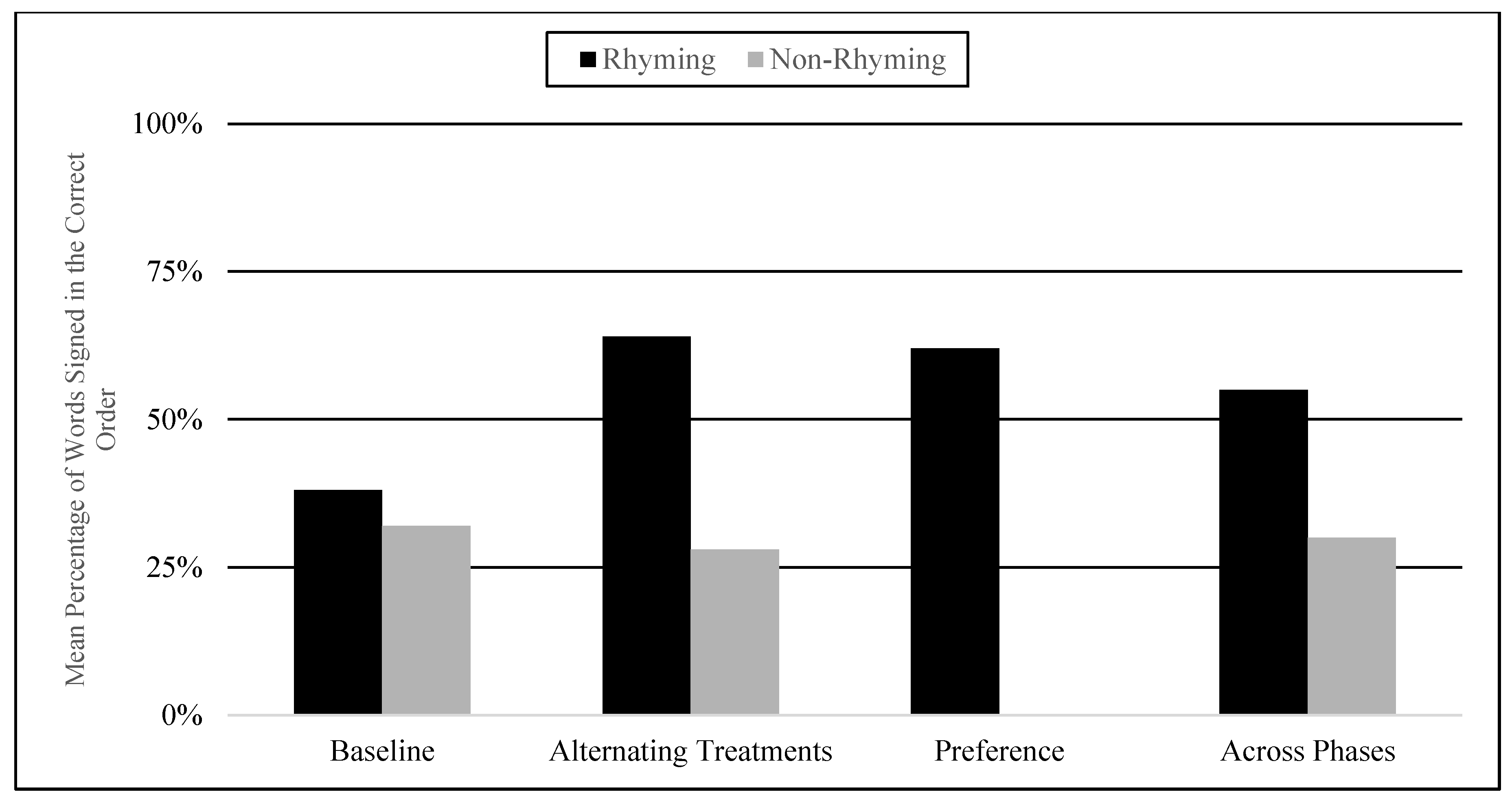

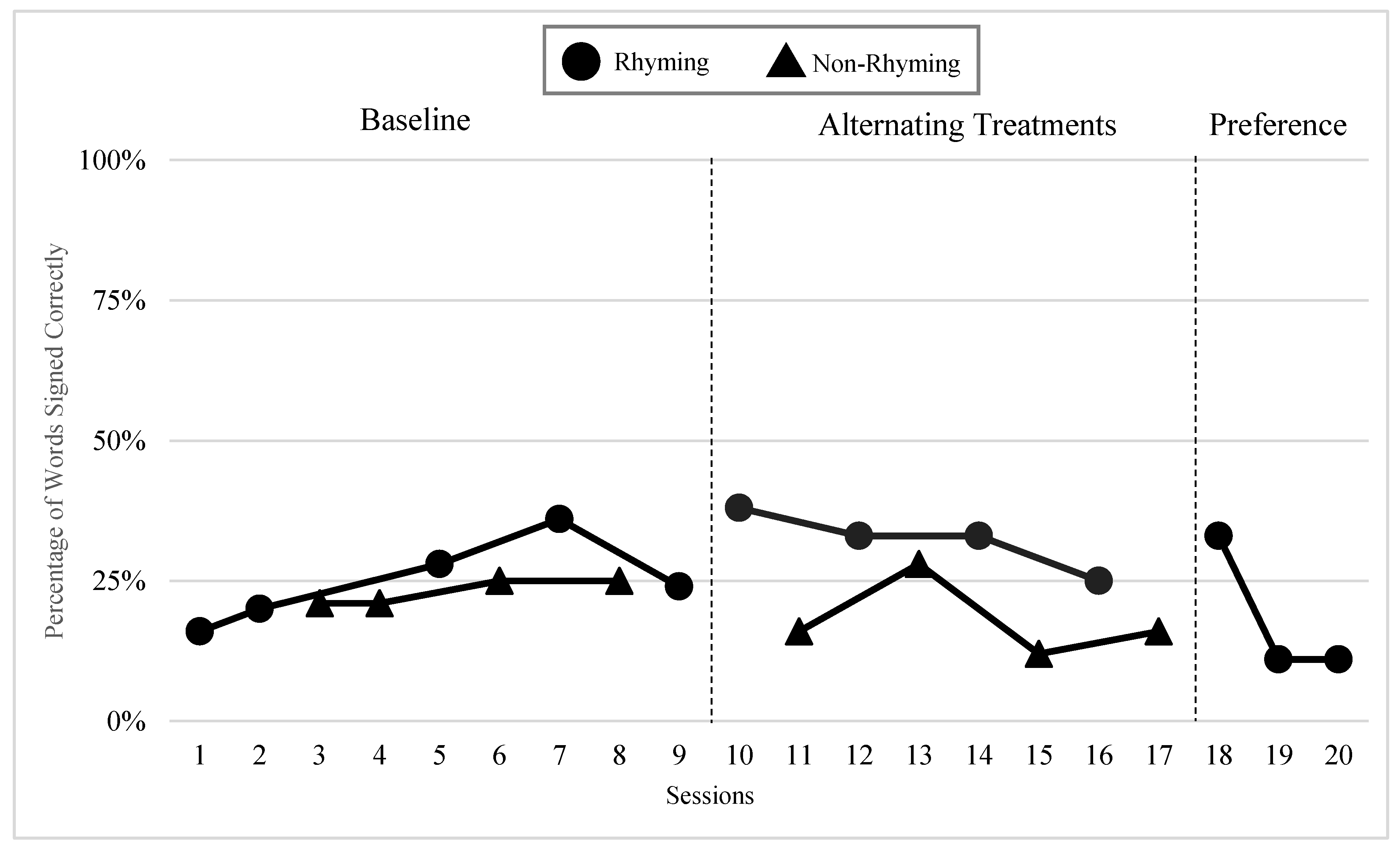
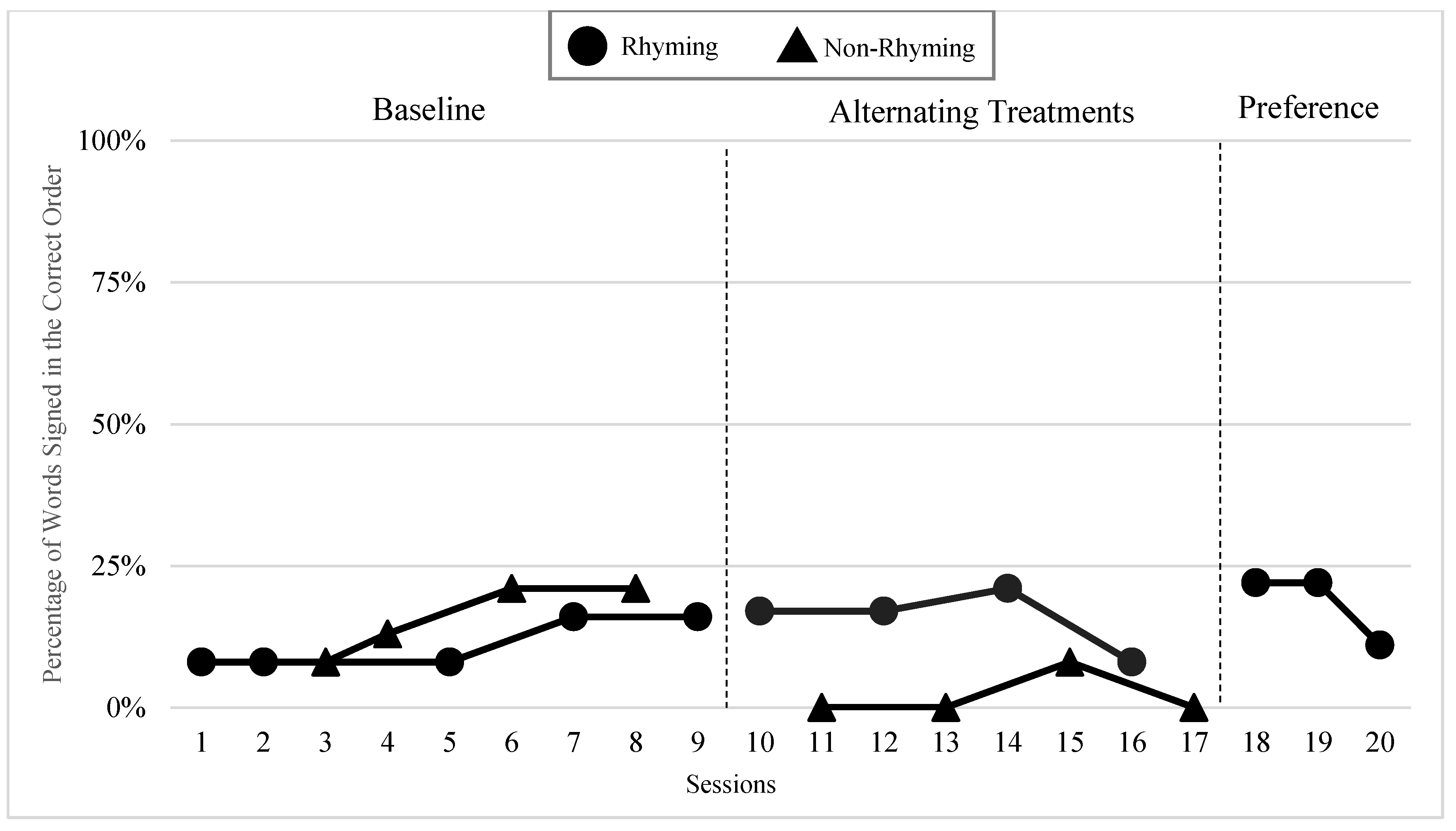

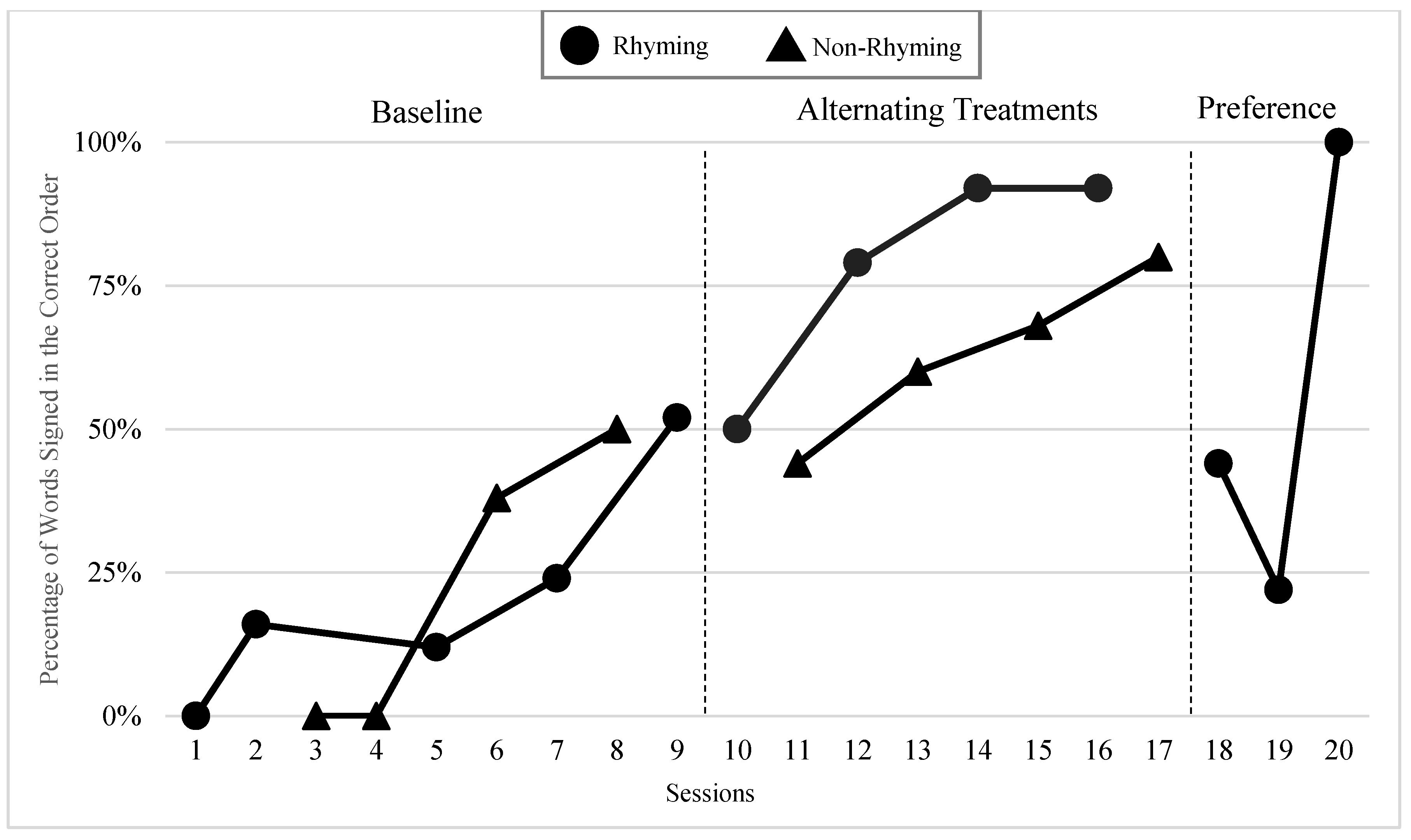
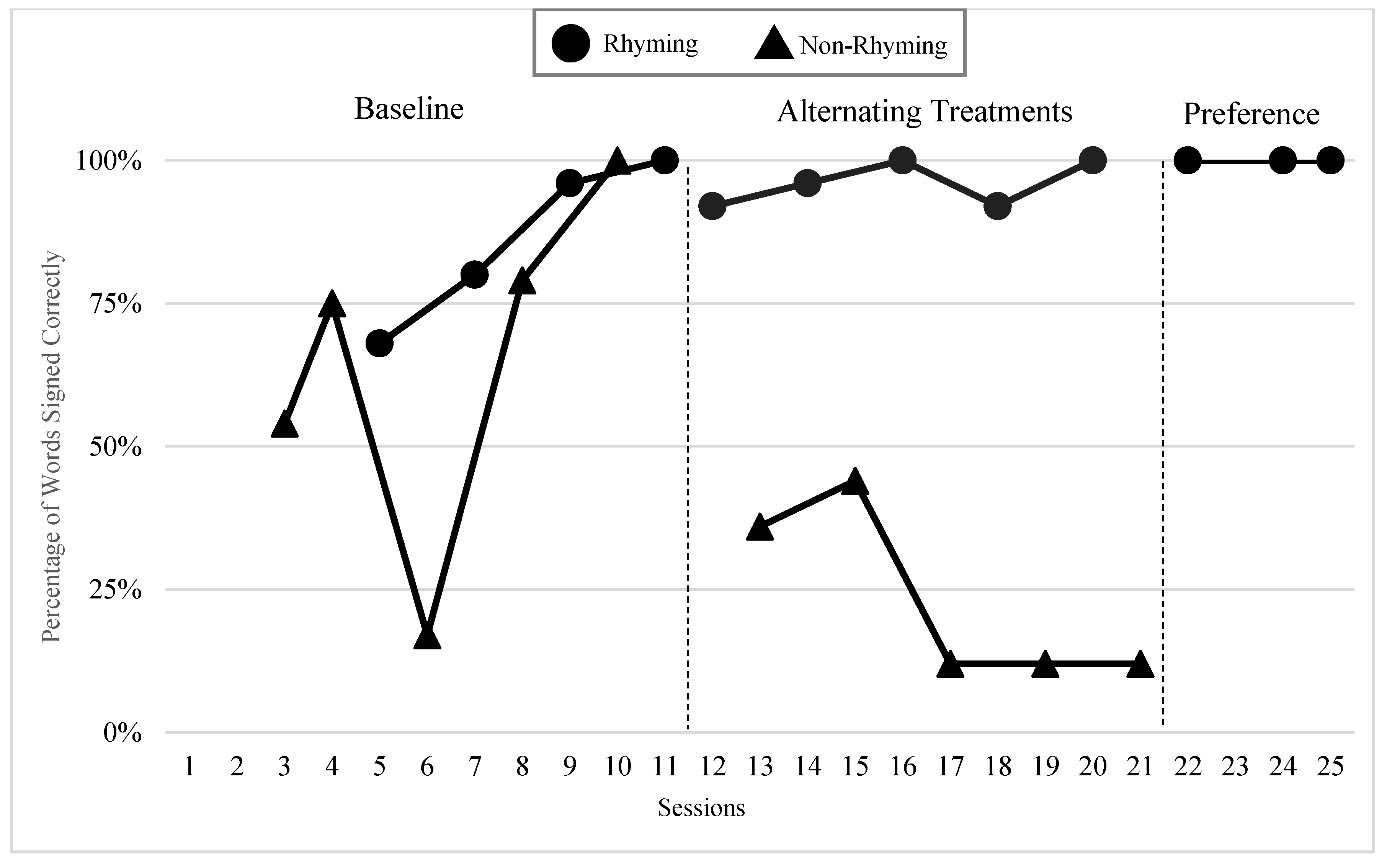
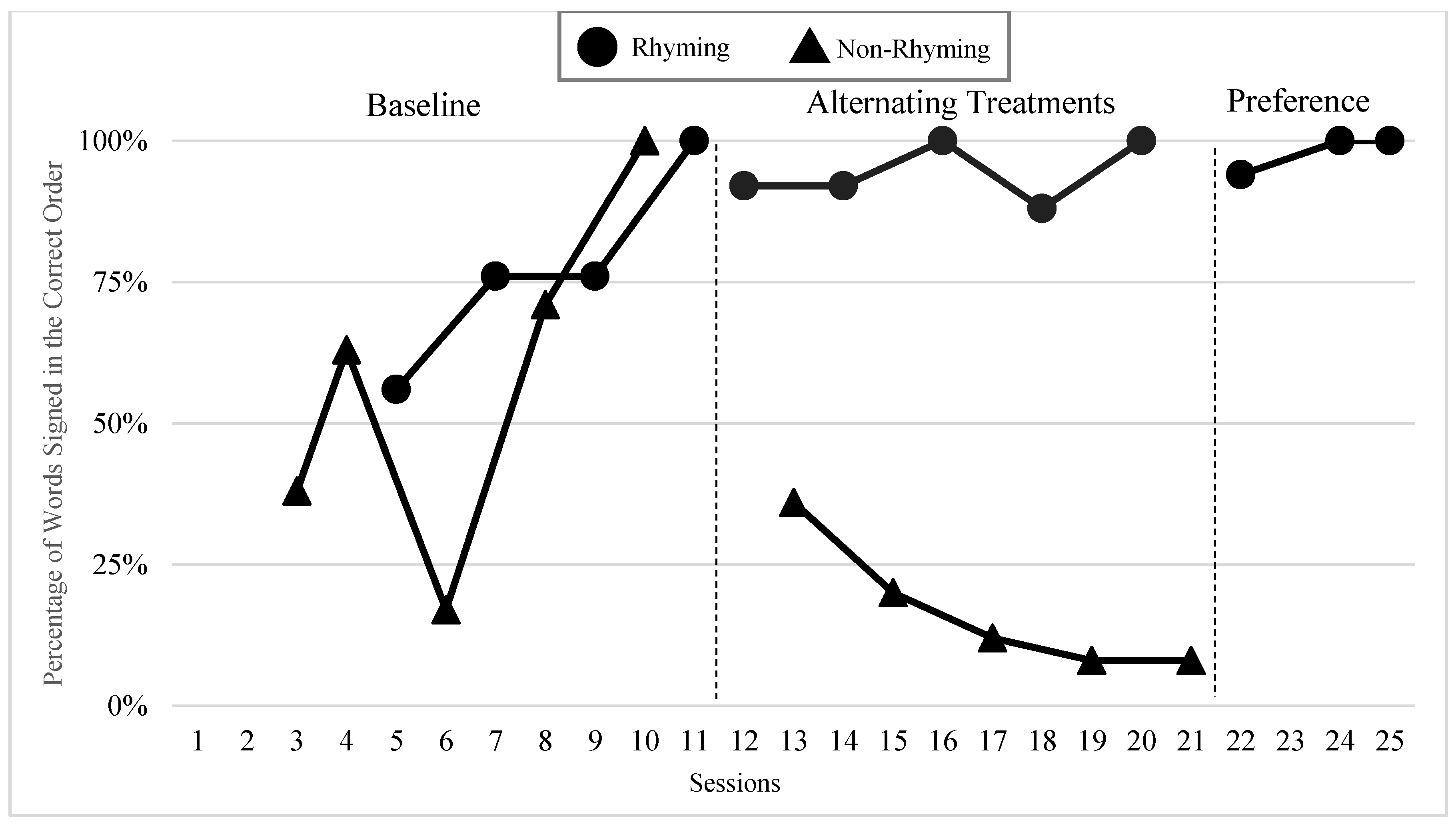
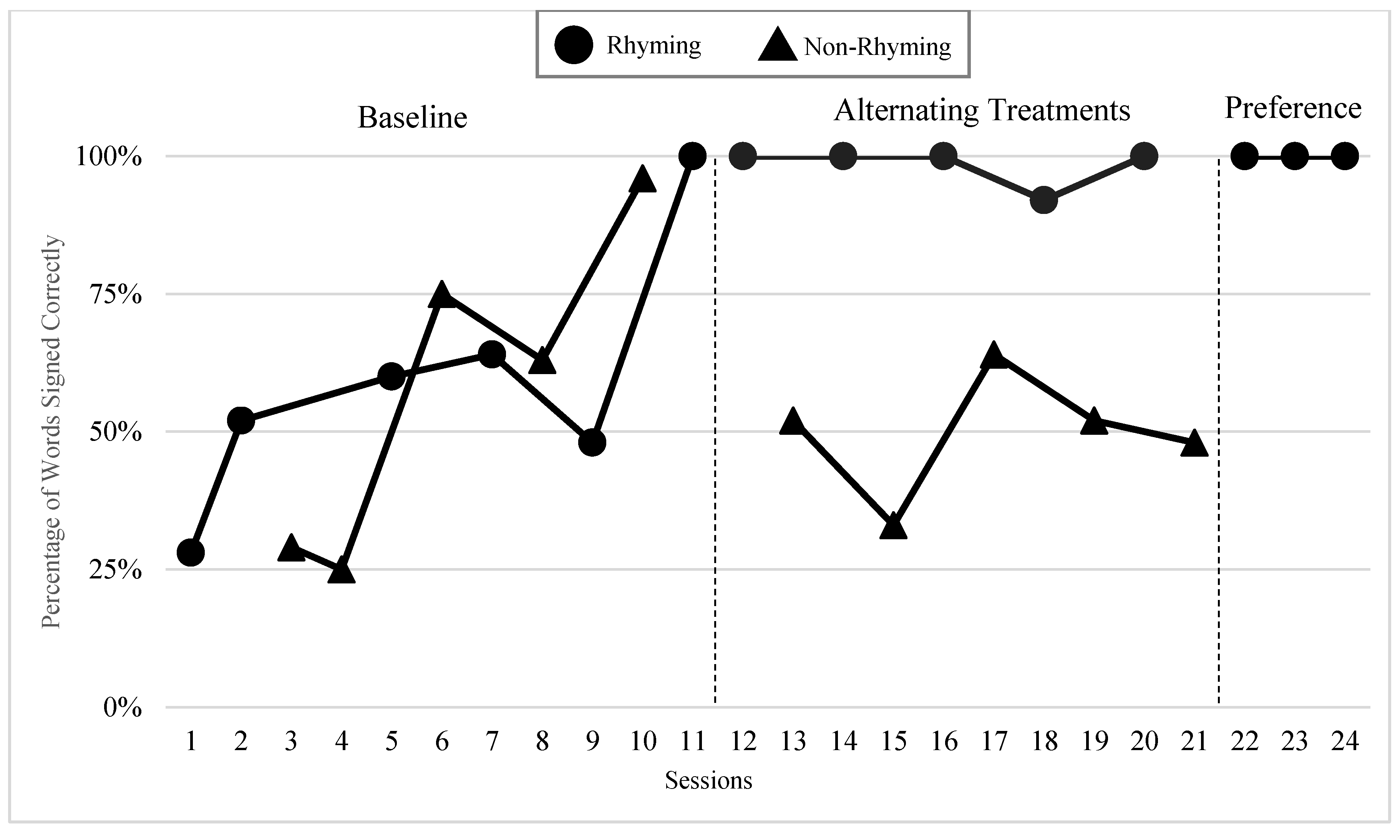
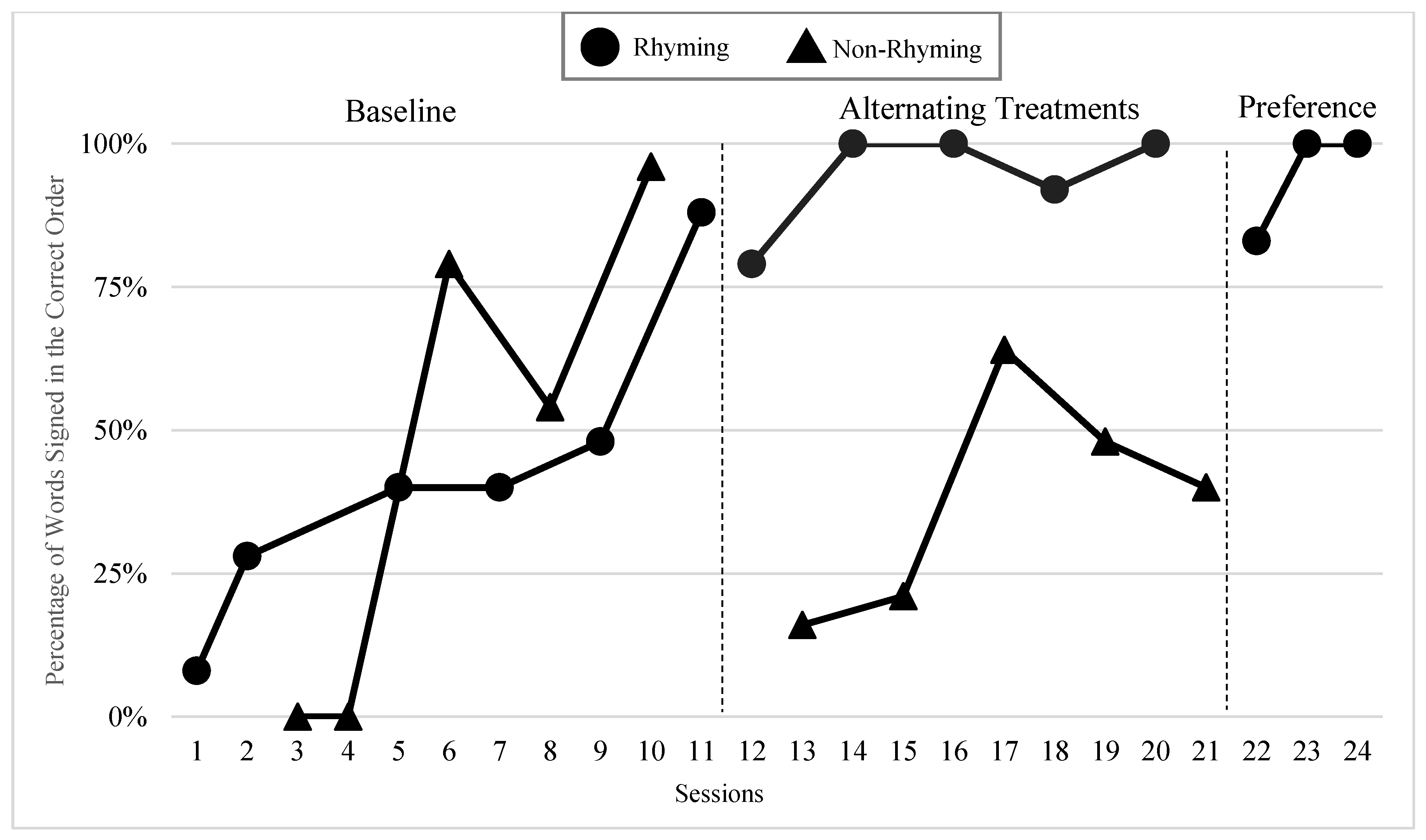


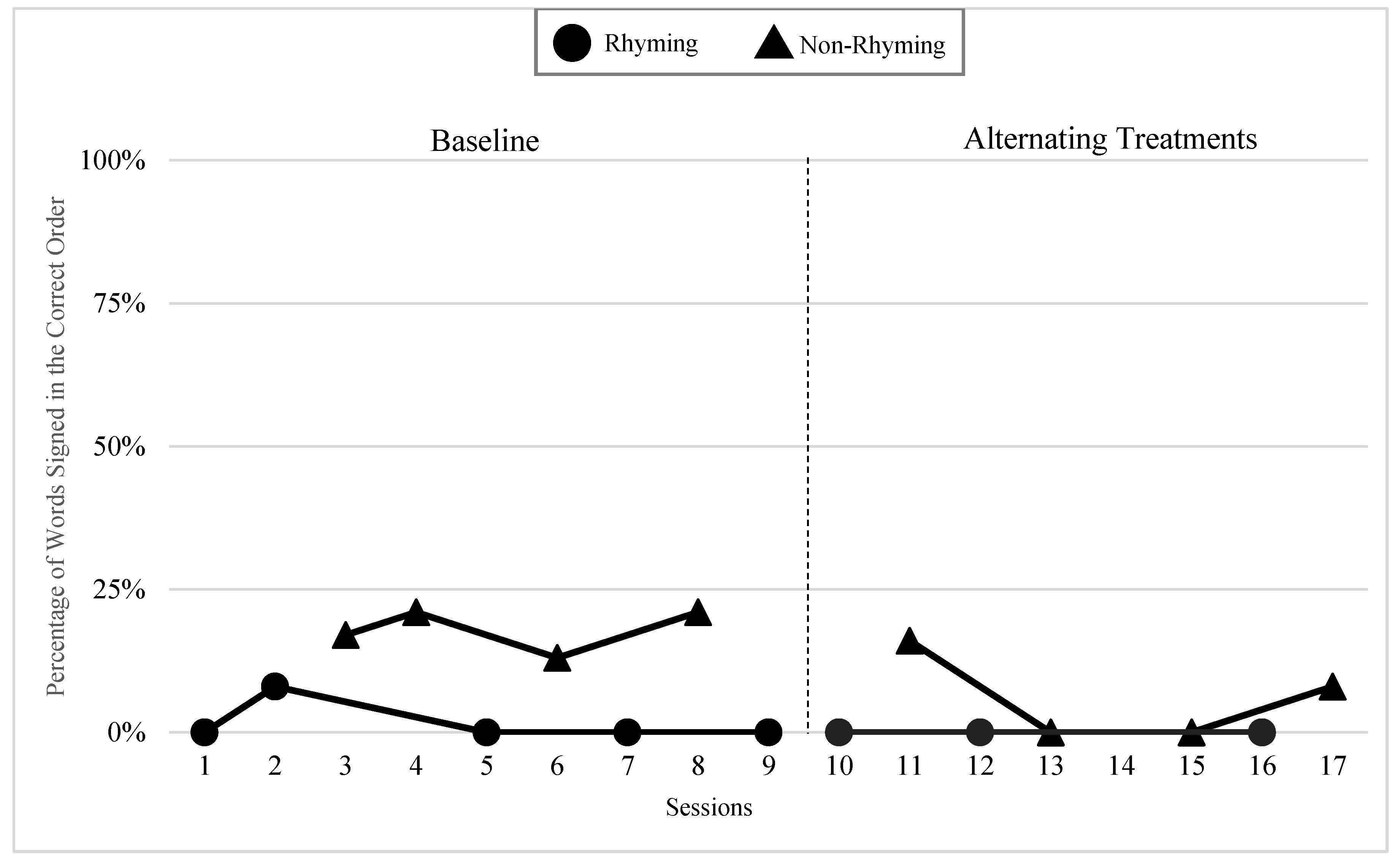
| Name | Class | Age | ASL | Vocab. | VCSL | Sex | Race | Disab. | P.H.S. | H.L. |
|---|---|---|---|---|---|---|---|---|---|---|
| Daya | P.S. | 4.6 | 3 years old | 10/23 | 2.7 | F | White | None | H + H | Eng. |
| Yair | P.S. | 4.10 | Birth | 16/23 | 2.4 | M | Asian | None | D + D | ASL |
| Giada | P.K. | 5.7 | 4 months old | 21/23 | 4.5 | M | White | None | H + H | ASL & Eng. |
| Jaslene | P.K. | 5.10 | Birth | 21/23 | 4.5 | M | Mixed | None | D + D | ASL |
| Lexie | P.K. | 6.5 | 4 years old (adop.) | 14/23 | 2.8 | F | Asian | None | D + D | ASL & Sign. Lang. |
| * Lacey | P.S. | 3.10 | Birth | 19/23 | 3.7 | F | Asian | None | D + D | ASL |
| Rhyming Version |
|---|
| (1) SPOT—ONE—MOUSE—CROSSING (1-handshape rhyme) (2) SEE—TWO—RACCOONS—CROSSING (2-handshape rhyme) (3) JAW DROP—THREE—ROOSTERS—CROSSING (3-handshape rhyme) (4) HAIR STAND—FOUR—ZEBRAS—CROSSING (4-handshape rhyme) (5) SHOCK—FIVE—DEER—CROSSING (5-handshape rhyme) (6) WALK—FINISH! (5-handshape rhyme) |
| Non-Rhyming Version |
|---|
| (1) SHOCK—ONE—ROOSTER—CROSSING (no handshape rhyme) (2) JAW DROP—TWO—ZEBRA—CROSSING (no handshape rhyme) (3) SPOT—THREE—DEER—CROSSING (no handshape rhyme) (4) SEE—FOUR—MICE—CROSSING (no handshape rhyme) (5) HAIR STAND—FIVE—RACCOONS—CROSSING (no handshape rhyme) (6) WALK—FINISH! |
Publisher’s Note: MDPI stays neutral with regard to jurisdictional claims in published maps and institutional affiliations. |
© 2020 by the authors. Licensee MDPI, Basel, Switzerland. This article is an open access article distributed under the terms and conditions of the Creative Commons Attribution (CC BY) license (http://creativecommons.org/licenses/by/4.0/).
Share and Cite
Holcomb, L.; Wolbers, K. Effects of ASL Rhyme and Rhythm on Deaf Children’s Engagement Behavior and Accuracy in Recitation: Evidence from a Single Case Design. Children 2020, 7, 256. https://0-doi-org.brum.beds.ac.uk/10.3390/children7120256
Holcomb L, Wolbers K. Effects of ASL Rhyme and Rhythm on Deaf Children’s Engagement Behavior and Accuracy in Recitation: Evidence from a Single Case Design. Children. 2020; 7(12):256. https://0-doi-org.brum.beds.ac.uk/10.3390/children7120256
Chicago/Turabian StyleHolcomb, Leala, and Kimberly Wolbers. 2020. "Effects of ASL Rhyme and Rhythm on Deaf Children’s Engagement Behavior and Accuracy in Recitation: Evidence from a Single Case Design" Children 7, no. 12: 256. https://0-doi-org.brum.beds.ac.uk/10.3390/children7120256





